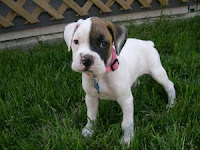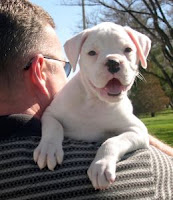 So you've found the most gorgeous Boxer Puppy on Earth. All the family adore him and everything seems to be perfect .... until someone says "What shall we call him?" I have found out through experience just how difficult this simple task can be!
So you've found the most gorgeous Boxer Puppy on Earth. All the family adore him and everything seems to be perfect .... until someone says "What shall we call him?" I have found out through experience just how difficult this simple task can be!
Of course you want a catchy, relevant and unique name for your new Boxer Dog, and rightly so. Unfortunately if nothing immediately springs to mind it can be a real problem, with each family member having their own favorite name and dis-regarding the suggestions of others.
If you are having difficulty choosing the right name for your new Boxer Dog Puppy, click on the paw button below for some great ideas!
Naming your Boxer Dog
Boxer Dog Training - Crate Training With Boxer Dogs
One of the most effective ways of house breaking any boxer puppy or boxer dog is crate training. Crate training is a very efficient and very effective training method, since it works with the na tural instinct of the boxer dog to achieve the desired result of a clean house and a well trained boxer dog.
tural instinct of the boxer dog to achieve the desired result of a clean house and a well trained boxer dog.
Basically the concept behind crate training is that a boxer dog naturally strives to avoid soiling the area where it eats and sleeps. By placing the boxer dog in the crate, this instinct is enhanced. The boxer dog will come to see the crate as its den, and it will try to avoid soiling its den.
The key to successful crate training for a boxer puppy or an older boxer dog, as with other forms of boxer dog training, is to establish a good routine. This routine will enhance the ability of the boxer dog to do its business in the right place, and avoid eliminating in the wrong place. It is important to shower the boxer dog with praise each and every time it eliminates in the established toilet area, and not to express frustration or anger when the boxer dog makes a mistake.
It is important to confine your boxer dog or boxer puppy to a small part of the house, generally one puppy proofed room, when you are not at home. The room should contain a soft bed, fresh water and some favorite toys to prevent your boxer dog from becoming bored and frustrated.
Crate training is different from confining your boxer dog to one room, however. With crate training, your boxer puppy or boxer dog is confined to a crate when unsupervised. The idea is that the boxer dog will think of this crate as its home, and not want to soil is home.
When crate training, it is important to remove the boxer dog from the crate as soon as possible after returning home, and to take the boxer dog promptly to the previously established toilet area. When the boxer dog does its business in this toilet area, be sure to provide lots of praise and treats. It is important that the boxer dog learn to associate proper toilet procedures with good things like treats and toys. It is important to never leave the boxer dog in its crate for long periods of time, as this will confuse the dog and force it to soil its sleeping area. The crate is simply a tool, and it should not be abused by leaving the boxer dog in it for extended periods of time. If the boxer dog is left in the crate for too long, it could set back the training program by weeks if not months.
The boxer dog should only be confined to the crate when you are at home. Except for at night the boxer dog should be given the opportunity to relieve itself every 45 minutes or so. Each time the boxer dog is taken out, it should be put on a leash and immediately taken outside. Once outside the house, the boxer dog should be given three to five minutes to do its business. If the dog does not eliminate in this time period, it should be immediately returned to the create.
If the boxer dog does its business during the set time period, it should be rewarded with praise, food, play, affection and either an extended walk or a period of play inside or outside the home. During the crate training period, it is important to keep a daily diary of when the dog does its business each day. If the dog is on a regular feeding schedule, the toilet schedule should be consistent as well. Having a good idea of when the dog needs to eliminate each day will be a big help during the house training process. After the dog has used his established toilet area, you will be able to give the dog free run of the house to play and enjoy himself.
Dealing with accidents during crate training
It is very important to not punish the puppy or boxer dog when it makes a mistake or has an accident during the crate training process. If there has been an accident, simply clean it up. Accidents during house training mean that you have provided the dog with unsupervised access to the house too quickly. The dog should not be allowed unsupervised access to the home until you can trust her bowel and bladder habits. If mistakes do occur, it is best to go back to crate training. Taking a couple of steps back will help move the house training process along, while moving too quickly could set things back.
John Samuels is the proud owner of two beautiful boxers called Napoleon and Buck. If you found this tip useful and would like some more tips on boxer care please visit my Boxer Dog Trainings site at http://boxerdogtraining.evenpick.com
Article Source: http://EzineArticles.com/?expert=John_Samuels
The Boxer Dog: Seeking the Ideal
If you are thinking about getting a purebred dog, and a Boxer dog in particular, you would be wise to familiarize yourself with what is known in the canine world as the “breed standard”.
Every country has a kennel club—In the U.S. it’s the American Kennel Club, or AKC, and for South America and most of Europe, it’s the Federacion Cynolgique Internationale, or FCI. Each ke nnel club has a system of registration, which issues the equivalent of “birth certificates”, guaranteeing that the parents of the dog to whom the certificate is assigned also have certificates. And the only way they got certificates is by having parents who also had them.
nnel club has a system of registration, which issues the equivalent of “birth certificates”, guaranteeing that the parents of the dog to whom the certificate is assigned also have certificates. And the only way they got certificates is by having parents who also had them.
Every kennel-club-registered dog has to have had registered ancestors going back at least five generations. So when you buy a registered Boxer dog, you are guaranteeing that it comes from a family which has been bred to meet the “breed standard”, meaning that there has been no blood from other breeds, or “outcross”, introduced into the mix since the time of its great-great-great grandparents.
That’s why each breed is recognizable as a distinct breed, and why a Boxer dog is very different from the German Bullenbeisser and English Bulldogs which were crossbred to produce what became the Boxer dog breed.
The breed standard gives prospective Boxer dog owners an idea of what to expect from their dogs, both in appearance and behavior. While it’s one thing to have a mental picture of how a champion Boxer dog should look, it’s quite another to have a clear idea of what living with a Boxer dog is like.
The breed standard for a the ideal Boxer dog, from the time they first appeared in Germany, has required that a Boxer dog be fearless and fiercely protective, while simultaneously being friendly, intelligent, willing to learn, and eager to please. If it lacks any of these traits, it has lost one of the things which makes a Boxer dog a Boxer dog.
The degree to which and individual Boxer dog meets the physical standard for the breed--the unique head and square, balanced muscular torso--are easily enough judged. But the temperament, even in a puppy born to the Boxer dog purple, must be nurtured. A responsible breeder will give you a puppy bred for stable temperament, but it’s up to you to lovingly socialize and train your puppy so that it becomes a Boxer dog worthy of its heritage!
Do you want to know find out loads more about how to train and raise you Boxer the proper way? Visit boxerdogessentials.com for more FREE info! Boxer Dog was written by freelance writer and boxer lover Rob Bogie.
Article Source: http://EzineArticles.com/?expert=Rob_Bogie
Are You Ready for a Boxer Dog Puppy?
 Most puppies are cute. But a Boxer dog puppy can take cute to an absurd level. Those enormous sad brown eyes, that impossibly short nose, that drooping mouth and that little body wriggling in paroxysms of delight--all of them make it seem that a Boxer dog puppy was designed to steal your heart before your head knows what is happening.
Most puppies are cute. But a Boxer dog puppy can take cute to an absurd level. Those enormous sad brown eyes, that impossibly short nose, that drooping mouth and that little body wriggling in paroxysms of delight--all of them make it seem that a Boxer dog puppy was designed to steal your heart before your head knows what is happening.
But inside that comical, antic, affectionate Boxer dog puppy lurks an intelligent, energetic, determined and strongly–willed Boxer dog, which at its adult height and weight will be a formidable canine indeed. And what you may not know about a Boxer dog puppy is that it will cling to puppyhood far longer than puppies of other breeds.
Your Boxer dog puppy will mature physically much sooner than it does mentally. Boxers need between three and four years to settle into dignified adulthood, and even then their degree of dignity will depend on how consistent their socialization and training has been..
You add a new member to the family the minute you bring a Boxer dog puppy home Boxer puppies are remarkably intelligent and eager to please, but if mishandled, will behave like class clowns. When brought into a home with other pets, they need to be socialized immediately so that they do not react with aggression or shyness.
If you have researched or, even better, spent time with Boxers, and understand the ongoing commitment required of Boxer owners, then you can start looking for a Boxer dog puppy. While you may lean toward getting one of the thousands of purebred Boxers surrendered for adoption each year, keep in mind that that you may have to overcome the mistakes of the dog’s previous owner.
Do some investigating before deciding to purchase a Boxer dog puppy from a pet shop. Many retail pet stores still get their animals from puppy mills, and you’ll have no way of checking the conditions under which your puppy came into the world.
If at all possible, get your Boxer dog puppy from a local breeder, whose facilities you can visit. See your puppy with its litter mates, and get an idea of its temperament. Does it seem to be the “leader” of the puppy pack, or is it shy and hiding behind its mother at your approach?
Are any recurring health problems in your prospective Boxer dog puppy’s family? Are you looking for a show dog? If you fall in love with a not-quite-championship-quality puppy, decide whether you want to sacrifice show potential for personality.
Plan on obedience classes and two hours of play time each day, or you will have a bored Boxer dog puppy. You shouldn’t expect your puppy to be ready for regular leash walks until it’s about ten months old, so make arrangements to keep it active in other ways. And crate train your puppy. It will be delighted to have its own space, and you’ll have somewhere to leave it for short periods when you can’t keep an eye on it.
A Boxer dog puppy is one of Mother Nature’s charmers, and over the years will return your love and loyalty a thousandfold!
Do you want to know find out loads more about how to train and raise you Boxer the proper way? Visit boxerdogessentials.com for more FREE info! Boxer Dog Puppy was written by freelance writer and boxer lover Rob Bogie.
Article Source: http://EzineArticles.com/?expert=Rob_Bogie
Dog Allergies
If your dog is itching, scratching and shedding like crazy, it is most likely due to dog allergies. The good news is that your dog doesn't have to suffer with allergies anymore! Dinovite® is a dog supplement that prevents and fights common dog allergies allowing your dog to be the happy healthy canine he was meant to be. Try Dinovite® for dog allergy relief today.
Boxer Dog Breed Origin and History
Boxer Dog Origin
The Boxer dog breed originates from Germany and finds its early ancestor to be a mastiff type dog, the large Molossian Hound. Later, this dog evolved into what was called the Bullenbeisser.  The Bullenbeiszer's roots go back to Belgium and these ancestors were known as great hunting and working dogs.
The Bullenbeiszer's roots go back to Belgium and these ancestors were known as great hunting and working dogs.
Originally used to hunt wild boar and later used for working with cattle these dogs eventually diverged into different types, the smaller of which were called the Brabanter Bullenbeiszer. After mixing with a forerunner of the English Bulldog, the dog became what is known today as the Boxer breed around the mid to late 19th century. The Boxer dog origin and history becomes well documented at that point as Boxer dog breed clubs were formed in Germany in the 1860s.
Boxer Dog Breed History
What we know of as the Boxer today can be traced to the 1830s when a breeder crossbred the Brabanter Bullenbeiszer with the English Bulldog, but the Boxer dog breed history really begins in the 1860s as breeders began to establish and develop guidelines for the breed. In 1895 the Boxer Club was formally formed and further improvements were made to the standards of the Boxer dog breed.
Although initially the Boxer dog breed was generally white, by 1925 white was not accepted as a proper color for the breed. In fact, the color of choice now is fawn and brindle and any dog with more than a third of its coat white will be disqualified in AKC events.
The Boxer dog breed came to the United States around the beginning of the 1900s but did not become a popular dog breed until the 1940s. The breed was first registered by the American Kennel Club in 1904 and the first Boxer Champion was recognized in 1915. In 1949 a famous Boxer dog, Bang Away, won Best in Show at the Westminster and went on to win 121 more Best in Shows over the course of six years.
Bang Away became a famous dog, appearing on the front of magazine such as Life and Esquire. Due to the success of this one dog, the Boxer dog breed became very popular in the United States at the time and continues to be one of the 10 most popular breeds as determined by the American Kennel Club.
Large Dog Boxer Breed Information and other large dog breeds can be found at LargeDogBreedz.com Please come visit the largest online dog breed community.
Article Source: http://EzineArticles.com/?expert=John_Hinkley
